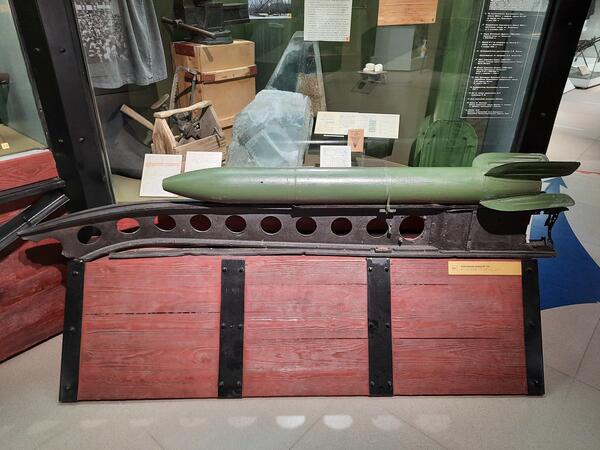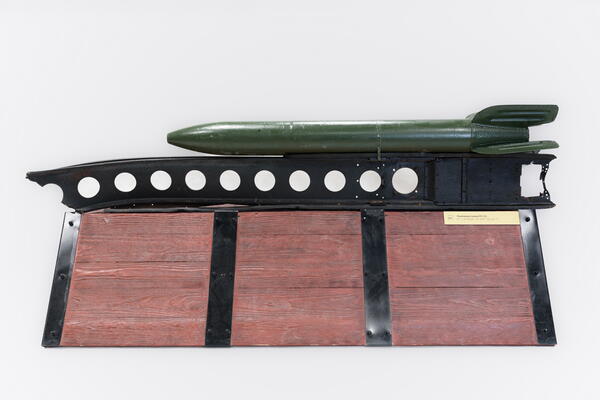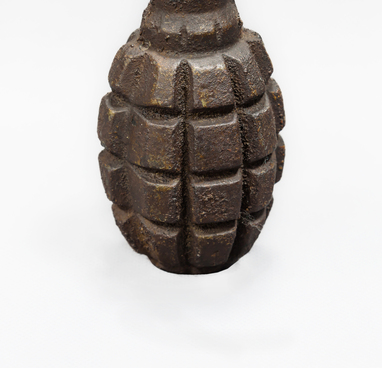The self-propelled multiple rocket launcher was developed for the M-13 rocket. Its first version, developed on the basis of the ZIS-5 truck and designated as MU-1 (mechanized launcher, the first prototype), had 24 launch rails mounted on a special frame in a transverse position relative to the longitudinal axis of the vehicle. Field tests were carried out in the period from December 1938 to February 1939 and showed that it did not fully meet the requirements.
Taking into account the test results, the Jet Propulsion Research Institute developed a new MU-2 launcher, which in September 1939 was accepted by the Main Artillery Directorate for field tests.
The range of a 42 kg M-13 projectile reached 8470 meters. It took 2–3 minutes to get the launcher ready to fire, the vertical launch angle ranged from 4 to 45 degrees, and the horizontal one was 20 degrees. The design of the launcher allowed it to move when fully loaded at a fairly high speed (up to 40 km/h) and quickly deploy in position, which made it possible to conduct surprise attacks against the enemy.
On June 21, 1941, at a review of prototypes of Red Army weapons, the launcher was presented to the leaders of the All-Union Communist Party of Bolsheviks and the Soviet government. It was decided to urgently start mass production of M-13 rocket projectiles and the launcher officially named BM-13 (Combat Vehicle 13).
BM-13 units were manufactured at the Voronezh Komintern Plant and at the Moscow Kompressor Plant. One of the main enterprises that produced the rockets was the Moscow Electromechanical Plant named after Vladimir Ilyich Lenin.
The first battery of field rocket artillery, sent to the front on the night of July 2, 1941 under the command of Ivan Andreyevich Flyorov, was armed with seven launchers. With its first salvo at 15:15 on July 14, 1941, the battery completely destroyed the Orsha railway junction along with German echelons and military equipment that were stationed there.
The exceptional effectiveness of Captain Flyorov’s battery and seven more such batteries formed after it contributed to a rapid increase in the rate of production of artillery weapons. By the fall of 1941, 45 divisions (each made up of three batteries) were taking part in battles. Each battery had four launchers. To arm the divisions, 593 BM-13 units were manufactured in 1941.
Taking into account the test results, the Jet Propulsion Research Institute developed a new MU-2 launcher, which in September 1939 was accepted by the Main Artillery Directorate for field tests.
The range of a 42 kg M-13 projectile reached 8470 meters. It took 2–3 minutes to get the launcher ready to fire, the vertical launch angle ranged from 4 to 45 degrees, and the horizontal one was 20 degrees. The design of the launcher allowed it to move when fully loaded at a fairly high speed (up to 40 km/h) and quickly deploy in position, which made it possible to conduct surprise attacks against the enemy.
On June 21, 1941, at a review of prototypes of Red Army weapons, the launcher was presented to the leaders of the All-Union Communist Party of Bolsheviks and the Soviet government. It was decided to urgently start mass production of M-13 rocket projectiles and the launcher officially named BM-13 (Combat Vehicle 13).
BM-13 units were manufactured at the Voronezh Komintern Plant and at the Moscow Kompressor Plant. One of the main enterprises that produced the rockets was the Moscow Electromechanical Plant named after Vladimir Ilyich Lenin.
The first battery of field rocket artillery, sent to the front on the night of July 2, 1941 under the command of Ivan Andreyevich Flyorov, was armed with seven launchers. With its first salvo at 15:15 on July 14, 1941, the battery completely destroyed the Orsha railway junction along with German echelons and military equipment that were stationed there.
The exceptional effectiveness of Captain Flyorov’s battery and seven more such batteries formed after it contributed to a rapid increase in the rate of production of artillery weapons. By the fall of 1941, 45 divisions (each made up of three batteries) were taking part in battles. Each battery had four launchers. To arm the divisions, 593 BM-13 units were manufactured in 1941.




